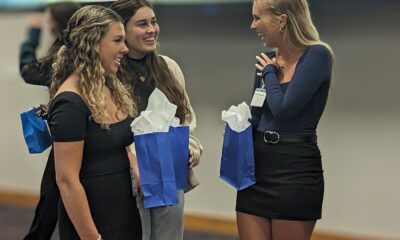Innovate
Through newly-created position, SPC and Amy Kickliter are building STEM bridges

The allure and unlimited promise of a freshly-minted position in higher education was almost enough to lure Amy Kickliter 3,100 miles across the country, away from Seattle and back to her hometown.
What tipped the scales was the allure and promise of St. Petersburg itself.
“This was a pretty sleepy little burg when I grew up here,” says Kickliter, who spent 25 career-and-family years away from Florida. “I’ve watched St. Pete evolve into a thriving community. There’s an independent spirit here that I’m very drawn to.
“That’s why I went to Seattle in the first place. It was a very locally-owned, very independent, fierce place. And it had a lot of heart, a lot of grit, and really believed in itself. I loved that.”
Kickliter has just started a job as manager of St. Pete College’s Bridges to the Baccalaureate Alliance Program, an ambitious national effort funded by a National Science Foundation grant. Its partners are Hillsborough Community College, State College of Florida in Manatee/Sarasota and University of South Florida’s Tampa and St. Pete campuses.
The goal is to raise the numbers in all-important STEM (science, technology, engineering and mathematics) education. Specifically, to increase the rate of minority students transferring from two-year to four-year degrees.
Many minority students, Kickliter says, have identity issues. “There isn’t a leap to ‘I’m a scientist,’ ‘I’m a mathematician,’ ‘I’m a physicist,’ for that particular population; they don’t see themselves in that way. So this grant is trying to work with all of those threats.”
According to research, a weakness in math is another common factor. “So we’re working on a gateway math program, to get them up to the pre-calculus level,” Kickliter explains. Each participating school, she says, will be teaching a different model, “exploring different ways of making it interesting.”
Already on the launch pad is a summer bridge program consisting of workshops, lectures and other activities.
In addition to operations funding, Kickliter explains, the FSA grant covers (for students):
- paid research and internships, attendance at STEM conferences for academic and career exposure.
- Annual regional summits focused on STEM opportunities and careers hosted by the Alliance.
- student tutors/mentors.
- faculty mentors.
- faculty development opportunities maximizing and integrating STEM best practices.
Kickliter’s enthused about the hands-on programs offered at SPC’s $4.7 million Bay Pines STEM Center, which opened last year after the college received $2.5 million from Florida Legislature Public Education Capital Outlay funds.
Its two state-of-the-art labs, with high definition equipment, have virtually unlimited research potential. SPC students enrolled in marine or environmental-themed courses can access all of the lab equipment, including microscopes, incubators, refrigerators, measuring and calibration equipment and autoclaves. “We want to drum up interest in moving kids into those areas,” Kickliter says.
“The goal for the alliance is for 450 students to transfer over the course of three years. We want this to move the dial on poverty, on minority students seeing themselves as scientists, physicists and engineers. Because there’s so much opportunity out there in the labor market. That’s what all the labor market research and information shows.
“So providing access and exposure, and cultivating interest in those fields and those careers, and helping students to learn that it doesn’t have to look like any one thing. It doesn’t have to look like a lab coat. It doesn’t have to look like something stodgy and boring. It can look like all different kinds of things.”
Kickliter spent the better part of the last 15 years doing grants management in higher education and workforce development. She was a senior manager and director of Self-Sufficiency Services at Neighborhood House, a social service agency in Washington’s Puget Sound region. “So this is the crux of what I’ve been doing for a very long time,” she explains.
Along the way, she says, she watched Seattle lose the independent spirit she had so admired. “It has a much more corporate infrastructure now. I’ll always love Seattle; it just got to be pretty homogenous.”
And so in the waning hours of 2017, Kickliter and her 5-year-old daughter made a smooth transition to the old hometown.
“St. Pete’s experiencing a beautiful time right now,” she enthuses. “There’s so much civic pride. Someone was telling me that between 30 and 40 new businesses opened on Central Avenue last year – and I think that’s amazing. It’s what I want my kid to grow up with. Mom and Pop stuff.”







